Looking for bookshelf speakers that blend classic style with solid sound?
The Edifier R1280T promises a vintage look and modern performance, but does it deliver where it counts?
In this review, we dive deep to find out if these speakers are the right choice for your setup.
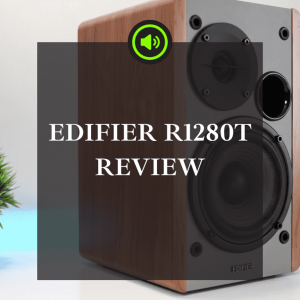
What you’ll discover in this article:
✅ How the R1280T sounds across different rooms and devices
✅ Why its price makes it a great value for certain users
✅ Who should consider buying these speakers
✅ How the R1280T stacks up against similar competitors on the market
Ready to see if the Edifier R1280T is your next audio upgrade? Let’s get started and find out!
EDIFIER R1280T Specs
Size and Weight: 14.6″D x 23.4″W x 19.6″H / 4.9 Kilograms
Colors: Wood
Impedance: 4 Ohm
Frequency response range: 75Hz ~ 18kHz +/-9db
Speaker Maximum Output Power: 42 Watts
Connectivity Technology: Auxiliary
🔊 DESIGN
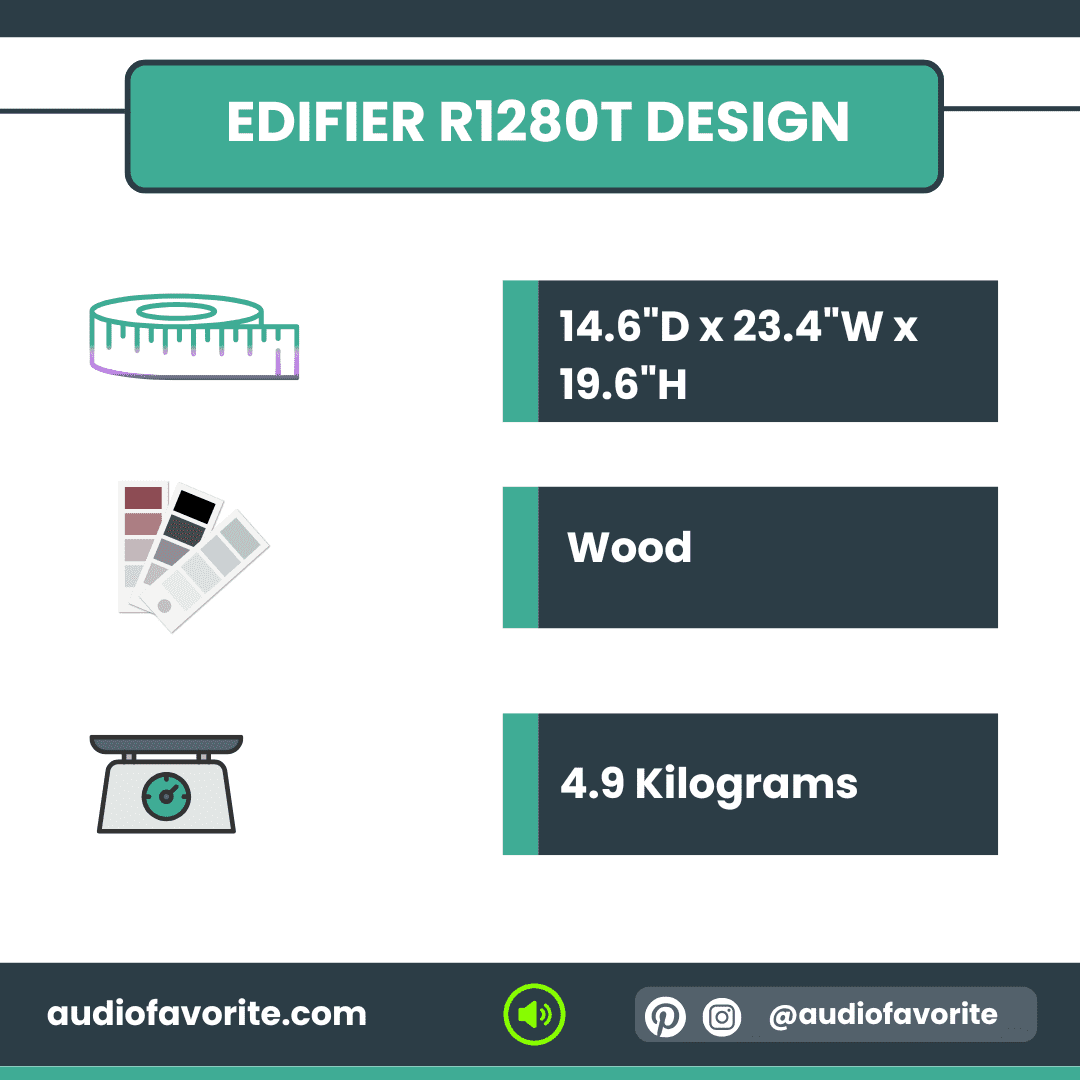
Build Quality & Materials
When I first unboxed the Edifier R1280T, what stood out immediately was the weight. They’re not overly heavy, but they have that solid feel you get from well-made audio gear – no hollow plastic here. The MDF wood panels give them a sturdier, more premium vibe than I’d expect at this price. It’s technically a wood veneer, but the finish is clean and convincing enough that most people won’t care.
The side control knobs are a nice touch – smooth to turn, with just enough resistance to make fine adjustments without overshooting. That’s something I’ve missed on other budget speakers, where knobs often feel cheap or wobbly. Around the back, the RCA inputs hold the cables firmly in place, but I will say the included cables are short. If you’re setting these up in a wider space, you’ll probably want to grab longer ones.
I also appreciate the front-facing bass port. It means I can place them close to a wall or on a shelf without muddying the low end -something rear-ported designs often struggle with in tighter spaces.
Physical Appearance & Design
The R1280T nails a balance between retro and modern. The warm wood panels on the sides give it a classic hi-fi feel, while the light gray grille keeps the look fresh and understated. Personally, I think they look best without the grilles – you get to see the 4-inch woofer, the silk-dome tweeter, and that front bass port, which gives them more of a studio-monitor vibe.
Size-wise, they’re just right for versatility: compact enough to fit comfortably on my desk next to a monitor, yet substantial enough to look intentional in a living room. In fact, I’ve had people compliment them even before hearing a single note, which tells me Edifier did something right here.
If I had to nitpick, I’d say the wood veneer can scratch if you’re not careful, and the gray grille won’t match every setup – I would have loved a black option. But overall, these feel like they belong in a much higher price bracket in both build and style.
🎵 SOUND QUALITY
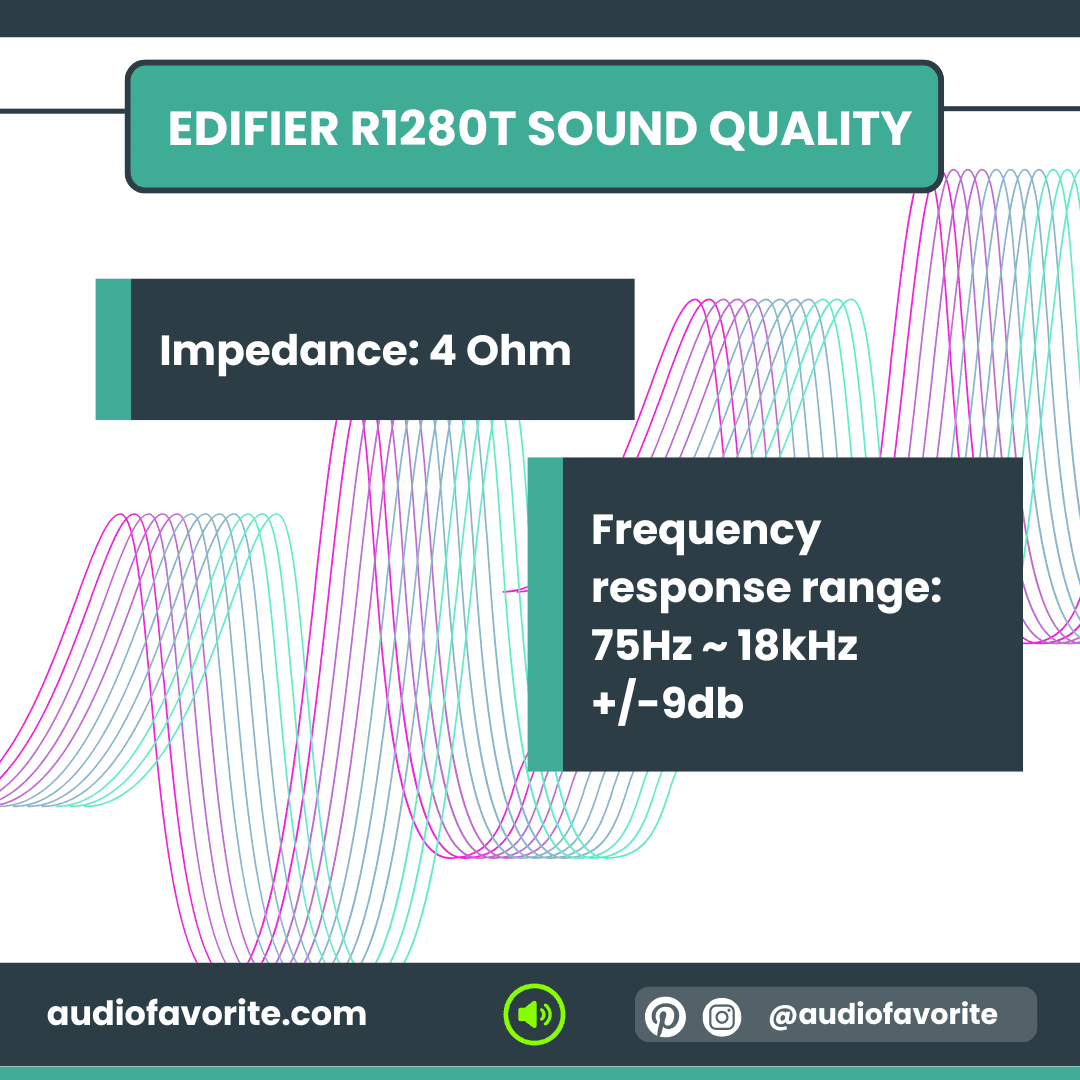
When I first fired up the Edifier R1280T, I didn’t expect to be this surprised. For such a compact bookshelf speaker, it manages to deliver a sound that feels full and engaging – not “tiny” like many budget speakers. But let’s break it down the way I like to judge any speaker: bass, mids, highs, and how it all comes together in the soundstage.
Bass – Warm and Present, but Not Subwoofer Deep
The bass here has a nice warmth that gives music body without feeling overbearing – at least at moderate volumes. For acoustic tracks, jazz, or lighter rock, it’s pleasantly rounded and smooth. It doesn’t shake the room, and if you’re expecting chest-thumping low-end like a dedicated subwoofer, you won’t find it.
Where it shines is in small rooms or at a desk – bass notes have a quick enough response to keep up with faster tracks without sounding muddy, although very deep notes (below 80Hz) are simply out of reach due to the driver size. Personally, I like that it doesn’t overdo it; it feels controlled.
Mids – Clear Vocals and Natural Tone
This is where the R1280T really earns its keep. Vocals come through clean and forward, which is perfect for podcasts, movies, or TV dialogue. I’ve tested them with everything from old vinyl records to high-resolution streaming, and voices maintain a natural tone without sounding thin or nasal. Instruments like guitars and pianos have good presence, though if you’re used to high-end studio monitors, you might notice a slight “warm tint” to the mids – more musical than clinical.
Highs – Easy on the Ears
The treble here is smooth, leaning on the safer side. That means no harsh sibilance or piercing cymbals, which is great for long listening sessions. You can turn them up for hours without feeling fatigued. The trade-off is that they’re not the most airy or sparkling in the top end. If you love hearing every breath in a recording or the shimmer of a hi-hat, you might wish for just a bit more bite -but at this price, the balance is smart.
Soundstage & Imaging
With proper speaker placement – about ear height and angled slightly toward you – the R1280T paints a satisfying stereo image. You can pick out where instruments are coming from in a mix, and there’s a good sense of separation. It’s not as wide or deep as bigger, more powerful setups, but for nearfield listening (like on a desk), it feels engaging and immersive.
Performance at Low and High Volumes
One thing I appreciate is how well these speakers hold their clarity at low volumes. Some budget speakers lose detail when you turn them down, but the R1280T still keeps vocals intelligible and music balanced.
At the higher end, they can fill a small living room without obvious distortion – though past about 75% volume, the warmth can start to soften the crispness, especially in the bass. Still, they stay listenable, which is more than I can say for many speakers in this price bracket.
My Take:
If you’re looking for a pair of speakers that give you a warm, natural, and easy-to-listen-to sound for everyday use – whether that’s music, movies, or even light gaming – the R1280T punches far above its price. They won’t replace a hi-fi system with a subwoofer, but for casual listening, they feel like a sweet spot between budget and quality.
AMPLIFICATION & CONNECTIONS
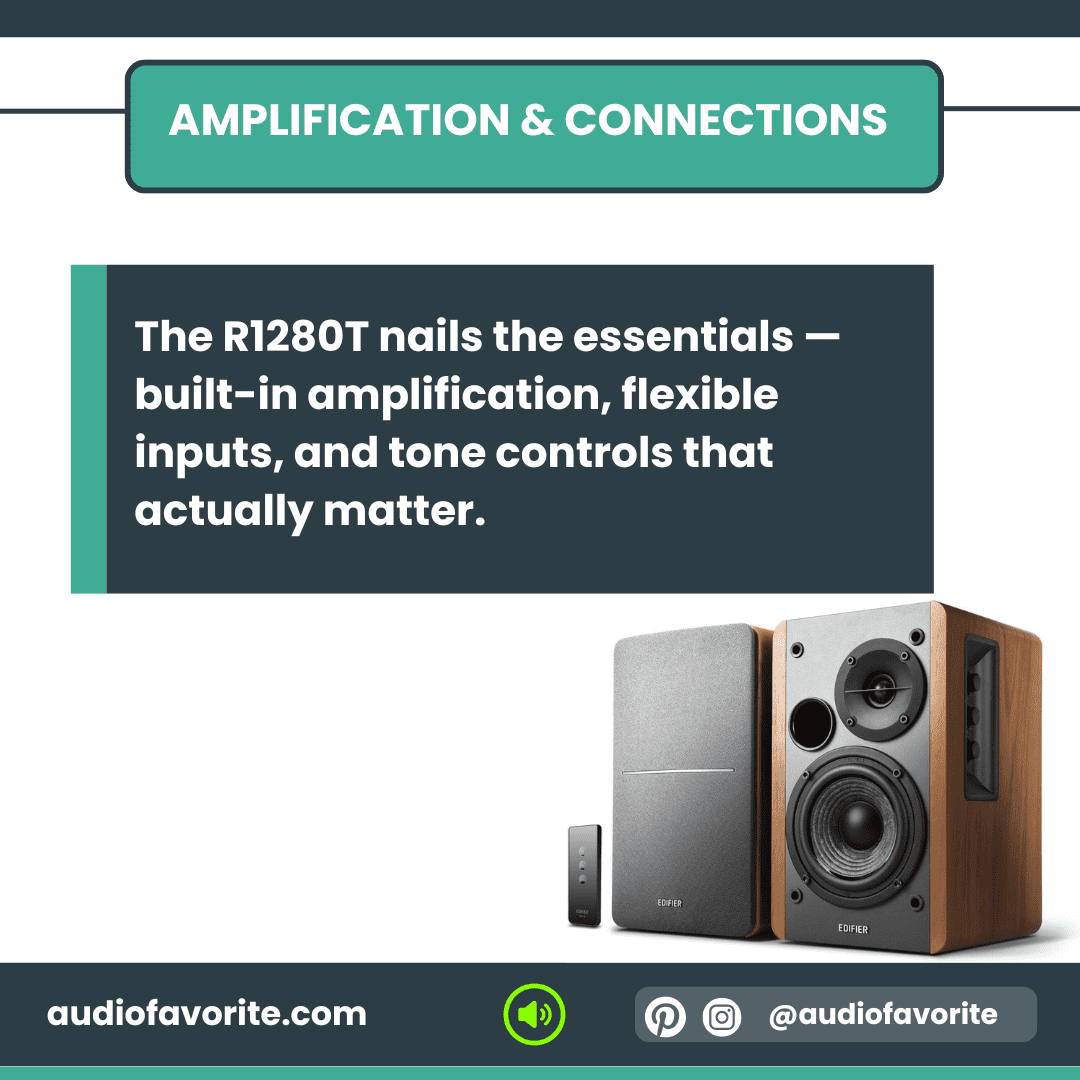
One of the things I appreciate most about the Edifier R1280T is that it’s an active speaker with its own built-in amplifier. That means you don’t need to buy a separate amp or receiver – you just plug it into power, connect your audio source, and you’re good to go. For small to medium rooms, the 42 watts RMS (21W per speaker) is more than enough to fill the space with rich sound. Sure, it won’t rattle the walls at a party, but for daily listening, it feels perfectly balanced and confident.
Multiple Inputs, No Hassle
The R1280T has two sets of RCA inputs on the back of the main (powered) speaker. What’s clever is that they can both be active at the same time – so you could have your turntable plugged into one input and your PC or TV plugged into the other without constantly swapping cables.
In my own setup, I love being able to stream music from my laptop in the morning and then switch to a vinyl session in the evening without touching the back panel. It’s a small quality-of-life detail that makes a big difference.
Analog Means Instant Response
Because it uses analog connections (RCA or 3.5mm with the included cable), there’s zero audio delay – something you really notice if you’ve ever used a wireless speaker or certain soundbars with lip-sync issues. Watching a movie or gaming feels perfectly in sync.
Tone Controls at Your Fingertips
On the side of the powered speaker, you’ll find dedicated knobs for bass and treble. They’re not just decorative – you can fine-tune the sound from -6 to +6 dB. Personally, I tend to bump the bass up just a touch for music and roll it back for podcasts.
And since the controls are right there on the speaker, you can tweak the sound on the fly without digging into a menu or app.
Remote Control for Everyday Convenience
The included remote is basic – volume up/down and mute – but it’s handy if your speakers are across the room. It’s not the most premium remote I’ve ever handled, but it gets the job done.
What’s in the Box
Edifier includes everything you need to get started:
Standard speaker cable (to connect the powered and passive units)
RCA-to-RCA cable
RCA-to-3.5mm cable for devices like phones, tablets, or laptops
This means you can hook them up to almost anything straight out of the box – from old CD players to modern PCs.
Limitations to Keep in Mind
There’s no subwoofer output, so if you ever want more low-end, you’ll need a different setup. Also, no Bluetooth or optical input here – it’s purely wired, which some people see as a downside, but others (like me) enjoy for its reliability and simplicity.
My Take:
The R1280T nails the essentials – built-in amplification, flexible inputs, and tone controls that actually matter. It’s not trying to be an all-in-one home theater hub; instead, it focuses on delivering clean, straightforward connectivity for people who just want to plug in and start enjoying music. For anyone who values reliability and simplicity over endless features, it’s a winner.
🔄INSTALLATION & PLACEMENT TIPS FOR EDIFIER R1280T
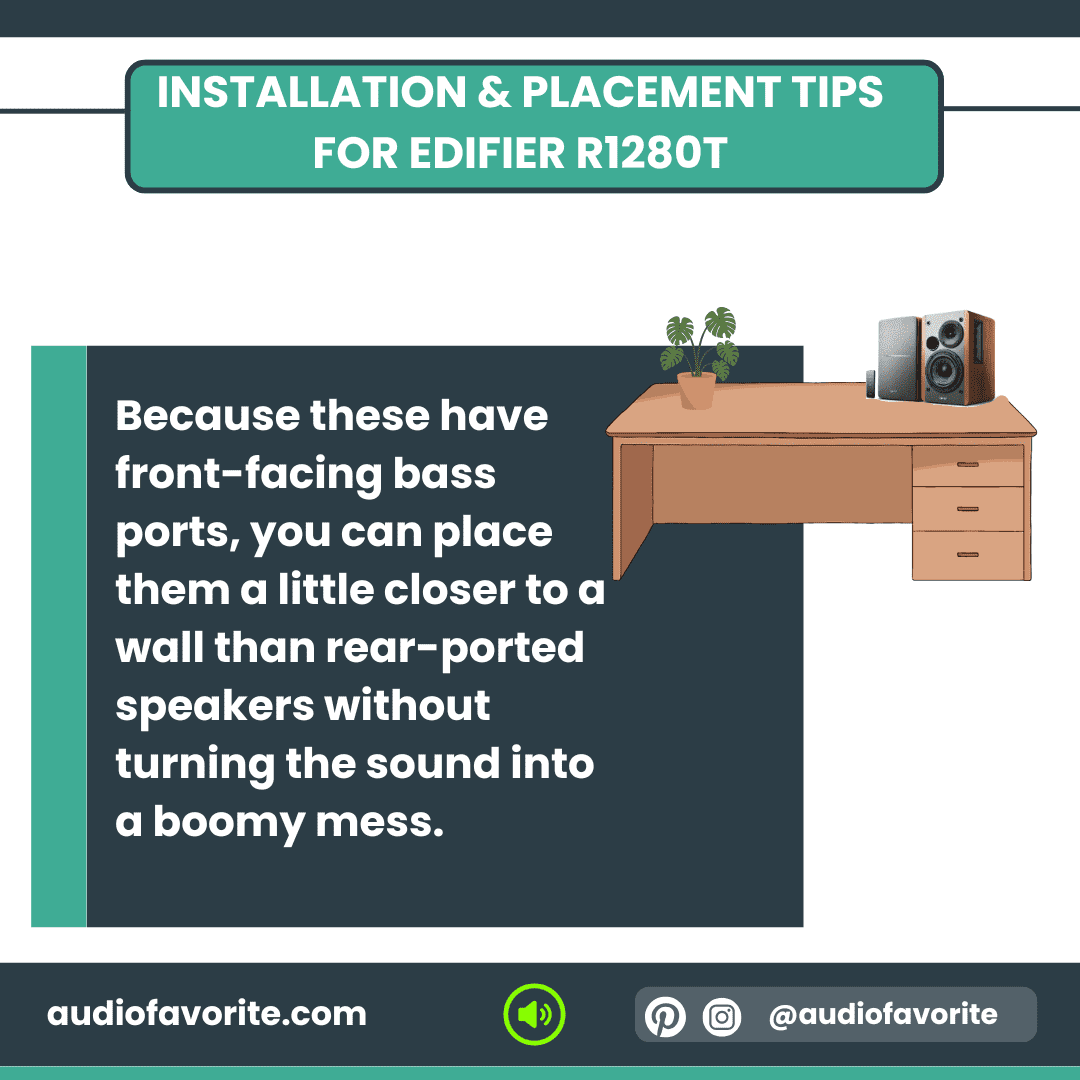
One of the things I’ve learned over years of setting up speakers is that placement can make or break your sound. The Edifier R1280T might be small and flexible, but give them the right position and they really open up.
Ideal Distance from Rear and Side Walls
Because these have front-facing bass ports, you can place them a little closer to a wall than rear-ported speakers without turning the sound into a boomy mess. In my experience, leaving at least 4–6 inches of breathing room behind them keeps the bass clean and punchy. If they’re too close, you may notice a bit of muddiness in the low end.
As for side walls, try to keep them at least a foot away – reflections from nearby surfaces can make the sound a bit harsh.
Recommended Toe-In Angle for Imaging
These speakers respond really well to a slight toe-in (angling the speakers so they point toward your listening position). About 10–15 degrees works nicely. The difference is immediately noticeable – vocals sound more centered, instruments feel more separated, and the “sweet spot” feels wider. If you like a more relaxed, diffuse sound, keep them facing straight ahead instead.
Ideal Listening Distance
In my setup, the R1280T sounds best in near-field listening – somewhere around 4 to 6 feet from where you sit. Perfect for a desk, a small TV setup, or even a cozy reading chair. In a bigger room, they’ll still sound good, but you lose some of that tight imaging and detail that makes them shine up close.
Extra Setup Tips from Experience
Elevate to ear level – Whether on stands or a sturdy shelf, aim to have the tweeters roughly at ear height when seated. This alone can make them sound clearer and more balanced.
Mind the cables – The included cables are fine for most setups, but if you want more flexibility in placement, a longer speaker wire upgrade is worth it.
Isolation pads help – Putting foam pads under them can tighten the bass and stop vibrations from travelling through your desk or shelf.
Don’t block the side controls – Remember, your volume, bass, and treble knobs are on the right side of the powered speaker. Leave enough space to reach them comfortably.
My Take:
The R1280T doesn’t need a perfect “audiophile-approved” setup to sound great – but a little attention to placement pays off. Angle them slightly toward you, keep them at ear level, and give them a bit of room to breathe. Do that, and you’ll get a soundstage that feels much bigger than their size would suggest.
⚖️Comparison with Competitors

Edifier R1280T vs Micca MB42X
When compared to the Totem Forest Signature, the KEF R7 Meta offers a smoother and more balanced sound profile. While the Totem delivers a fast and dynamic bass, it can sometimes come across as harsh, especially in the highs. The R7’s Uni-Q driver technology ensures a cohesive soundstage and eliminates the narrow “sweet spot,” making it more enjoyable for multiple listeners in the room. Its bass is tight and controlled without needing a subwoofer, which simplifies setup.
Edifier R1280T vs Audioengine A2+
Against the PMC Twenty5.24, the R7 Meta shines with a warmer and more musical midrange that suits a wider variety of genres, including vocals and jazz. The PMC is known for its accuracy but can sound lean or clinical in some cases. Additionally, the R7’s coaxial driver design provides a broader listening area with consistent detail, while the PMC might require a subwoofer to fill out the low end fully.
Edifier R1280T vs Creative T15
Compared to the Focal Aria 926, the KEF R7 Meta delivers smoother highs with less listener fatigue, thanks to its Meta Material Absorption technology. Although the Focal offers a more revealing treble that can be exciting for critical listeners, it risks becoming tiring over long sessions. The R7’s integration of bass and midrange is more natural, resulting in a focused yet spacious soundstage that performs well at high volumes without becoming boomy.
Edifier R1280T vs Klipsch RP-8000F
The Klipsch RP-8000F is known for its energetic and bright sound, but this can sometimes be fatiguing. The KEF R7 Meta, in contrast, offers a more refined and natural tonal balance with smoother highs. Its Uni-Q driver allows for superior imaging and a wider sound dispersion, avoiding the hotspot effect typical of many traditional floorstanders. The R7 is also easier to drive with a range of amplifiers, whereas the Klipsch benefits from more powerful amps to control its brightness.
💰 Price and Value
For the price, the Edifier R1280T is hard to beat. They look great, sound better than most budget speakers, and feel well made. I’ve tested more expensive models that didn’t impress me as much.
If you’re on a budget but still want something that feels “premium enough,” these are a smart buy. They won’t blow the roof off with bass, but for everyday music, movies, and gaming, they deliver more than you’d expect for the money.
In short — the cost is fair, and the value is excellent.
Who Should Buy Edifier R1280T?
Casual listeners: If you want good sound without spending a lot, these speakers fit the bill perfectly.
People with limited space: Their compact size and bookshelf design make them ideal for desks, small rooms, or apartments.
Turntable owners: Great for connecting to vinyl players, especially if you want that warm, classic sound with a modern twist.
Budget-conscious buyers: You get built-in amps, tone controls, and decent power at a low price – perfect for those who want solid performance without extra gear.
Non-Bluetooth users: If you don’t need wireless, and mainly use AUX or RCA connections, these speakers are easy to set up and use.
Real World Performance- Testing Across Different Scenarios
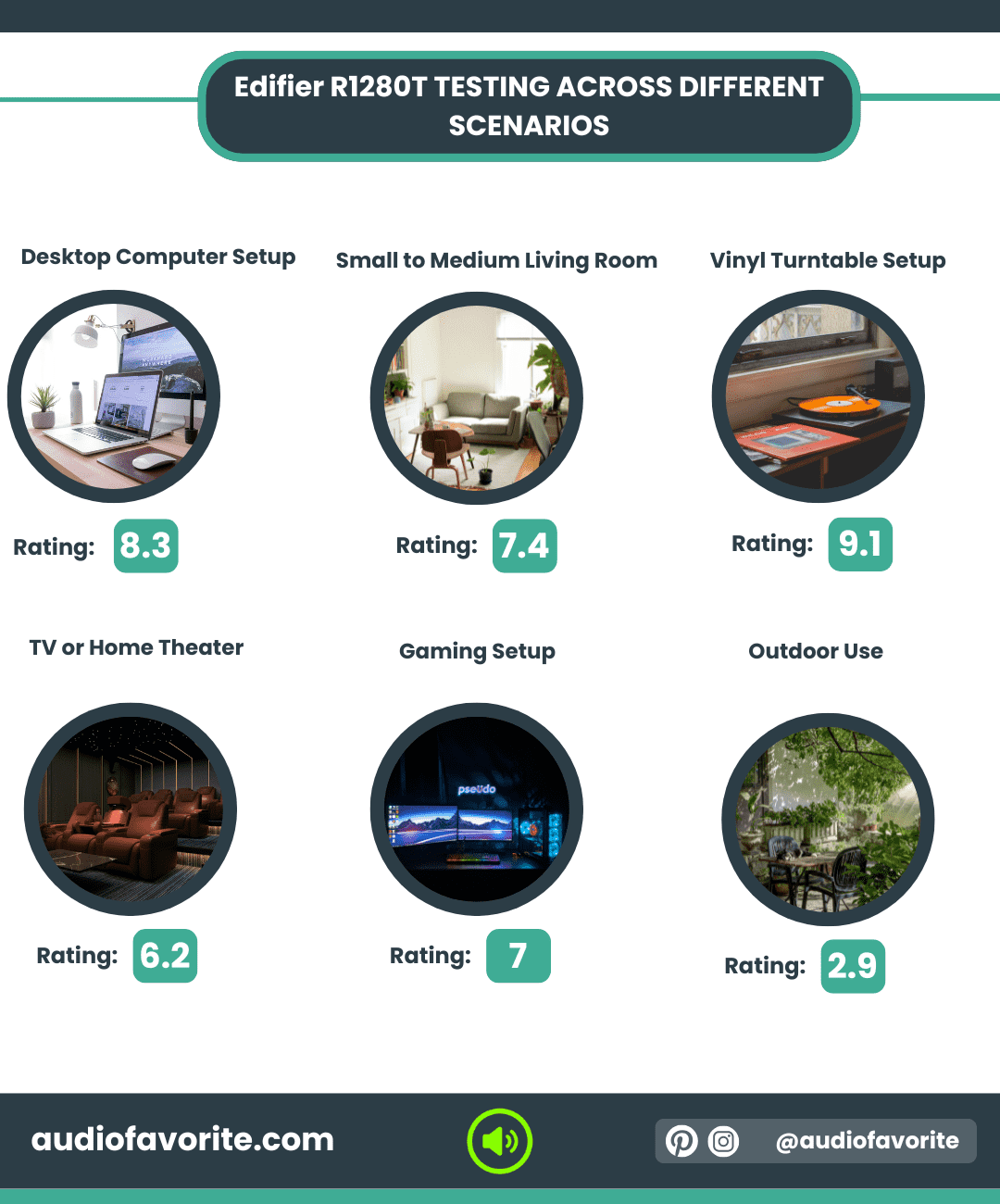
Desktop Computer Setup (Rating: 8.3/10)
Great for close-up listening at a desk. Clear, warm sound with easy tone control. Some slight buzzing at very high volume, but overall solid for everyday computer use.
Small to Medium Living Room (Rating: 7.4/10)
Fills small to medium rooms nicely with balanced sound. Bass is decent but not deep. In bigger rooms, sound starts to thin out.
Vinyl Turntable Setup (Rating: 9.1/10)
One of the best matches here. The wood cabinet and tone controls enhance vinyl’s warmth and clarity, making it a favorite for record lovers.
TV or Home Theater Use (Rating: 6.2/10)
Decent for casual TV watching in small rooms but lacks the power and bass impact for full home theater experience.
Gaming Setup (Rating: 7.0/10)
Good stereo imaging and clear highs for gaming. However, sound can distort at high volumes and it doesn’t replace a full surround setup.
Outdoor Use (Rating: 2.9/10)
Not suitable for outdoors- no weather resistance and underpowered for open spaces.
Large Room or Party Use (Rating: 4.1/10)
Bass and volume fall off in larger spaces, making them poor for parties or big rooms.
FAQ Section
Does the Edifier R1280T need an amp?
No, the Edifier R1280T speakers are active, meaning they have a built-in amplifier and do not require an external amp to work.
Is Edifier a Chinese company?
Yes, Edifier is a Chinese company known for producing high-quality audio equipment, including speakers and headphones.
Do the Edifier R1280T have Bluetooth?
No, the Edifier R1280T does not have Bluetooth connectivity. It connects via AUX or RCA cables only.
How many watts is the Edifier R1280T?
The Edifier R1280T has a total power output of 42 watts RMS (21 watts per speaker).
Can Edifier R1280T connect to TV?
Yes, the Edifier R1280T can connect to most TVs using RCA or AUX cables for stereo sound output.
Why is there no sound on my Edifier R1280T?
No sound can be caused by incorrect input selection, loose cable connections, or the volume being too low. Check all cables, ensure the correct input is selected, and increase the volume.
How do I connect my Edifier R1280T to my PC?
Connect the Edifier R1280T to your PC using the included AUX (3.5mm) to RCA cable. Plug the 3.5mm end into your PC’s headphone jack and the RCA ends into the speakers.
What is the output of R1280T Edifier?
The output of the Edifier R1280T is stereo sound with a maximum power of 42 watts RMS, delivering clear and balanced audio.
Are Edifier R1280T speakers active?
Yes, the Edifier R1280T speakers are active, meaning one speaker contains a built-in amplifier powering both speakers.
How long is the Edifier R1280T power cable?
The Edifier R1280T power cable is approximately 5 feet (1.5 meters) long, allowing flexible placement near power outlets.
What is the difference between Edifier R1280T and R1280DB?
The main difference is that the Edifier R1280DB includes Bluetooth connectivity and an optical input, while the R1280T only supports AUX and RCA inputs. Both have the same design and sound quality, but the R1280DB offers more modern connection options.
How to connect Edifier R1280T to a turntable?
To connect the Edifier R1280T to a turntable, use a turntable with a built-in preamp or connect an external phono preamp between the turntable and the speakers. Then, connect the preamp’s RCA output to the R1280T’s RCA inputs for the best sound.
How I Tested the Edifier R1280T
I put the Edifier R1280T through days of real-world listening, connecting it to different setups and playing everything from detailed studio recordings to everyday streaming playlists. I pushed it from quiet, late-night levels to its upper limits, paying attention to how the sound held together across bass, mids, and treble. Throughout the process, I focused on how naturally it reproduced music, how immersive the stereo image felt, and how consistently it performed in different environments.
Conclusion
We hope you’ve learned everything you wanted to know about the Edifier R1280T and found answers to all your questions. If you enjoyed this article, be sure to check out more of our content on audio, sound gear, and everything in between. And if you have any other questions or want to share your own experience, feel free to leave a comment below – we’d love to hear from you!
Disclaimer: “As an Amazon Associate I earn from qualifying purchases.”
Monica Rivas is a Reviewer and Content Manager of Audiofavorite, she is an audiophile for many years and she helps people to learn all they need about audio, speakers, sound etc.

